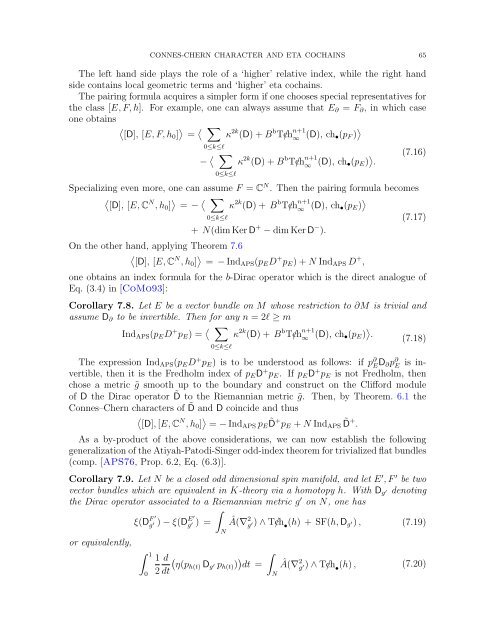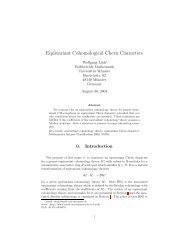Connes-Chern Character for Manifolds with Boundary and ETA ...
Connes-Chern Character for Manifolds with Boundary and ETA ...
Connes-Chern Character for Manifolds with Boundary and ETA ...
Create successful ePaper yourself
Turn your PDF publications into a flip-book with our unique Google optimized e-Paper software.
CONNES-CHERN CHARACTER AND <strong>ETA</strong> COCHAINS 65<br />
The left h<strong>and</strong> side plays the role of a ‘higher’ relative index, while the right h<strong>and</strong><br />
side contains local geometric terms <strong>and</strong> ‘higher’ eta cochains.<br />
The pairing <strong>for</strong>mula acquires a simpler <strong>for</strong>m if one chooses special representatives <strong>for</strong><br />
the class [E, F, h]. For example, one can always assume that E ∂ = F ∂ , in which case<br />
one obtains 〈[D],<br />
[E, F, h0 ] 〉 = 〈 ∑<br />
κ 2k (D) + B b T/ch n+1<br />
∞ (D), ch •(p F ) 〉<br />
0≤k≤l<br />
− 〈 ∑<br />
0≤k≤l<br />
κ 2k (D) + B b T/ch n+1<br />
∞ (D), ch •(p E ) 〉 .<br />
(7.16)<br />
Specializing even more, one can assume F = C N . Then the pairing <strong>for</strong>mula becomes<br />
〈<br />
[D], [E, C N , h 0 ] 〉 = − 〈 ∑<br />
κ 2k (D) + B b T/ch n+1<br />
∞ (D), ch •(p E ) 〉<br />
0≤k≤l<br />
+ N(dim Ker D + − dim Ker D − ).<br />
On the other h<strong>and</strong>, applying Theorem 7.6<br />
〈<br />
[D], [E, C N , h 0 ] 〉 = − Ind APS (p E D + p E ) + N Ind APS D + ,<br />
(7.17)<br />
one obtains an index <strong>for</strong>mula <strong>for</strong> the b-Dirac operator which is the direct analogue of<br />
Eq. (3.4) in [CoMo93]:<br />
Corollary 7.8. Let E be a vector bundle on M whose restriction to ∂M is trivial <strong>and</strong><br />
assume D ∂ to be invertible. Then <strong>for</strong> any n = 2l ≥ m<br />
Ind APS (p E D + p E ) = 〈 ∑<br />
κ 2k (D) + B b T/ch n+1<br />
∞ (D), ch •(p E ) 〉 .<br />
(7.18)<br />
0≤k≤l<br />
The expression Ind APS (p E D + p E ) is to be understood as follows: if p ∂ E D ∂p ∂ E is invertible,<br />
then it is the Fredholm index of p E D + p E . If p E D + p E is not Fredholm, then<br />
chose a metric ˜g smooth up to the boundary <strong>and</strong> construct on the Clif<strong>for</strong>d module<br />
of D the Dirac operator ˜D to the Riemannian metric ˜g. Then, by Theorem. 6.1 the<br />
<strong>Connes</strong>–<strong>Chern</strong> characters of ˜D <strong>and</strong> D coincide <strong>and</strong> thus<br />
〈<br />
[D], [E, C N , h 0 ] 〉 = − Ind APS p ˜D+ E p E + N Ind ˜D+ APS .<br />
As a by-product of the above considerations, we can now establish the following<br />
generalization of the Atiyah-Patodi-Singer odd-index theorem <strong>for</strong> trivialized flat bundles<br />
(comp. [APS76, Prop. 6.2, Eq. (6.3)].<br />
Corollary 7.9. Let N be a closed odd dimensional spin manifold, <strong>and</strong> let E ′ , F ′ be two<br />
vector bundles which are equivalent in K-theory via a homotopy h. With D g ′ denoting<br />
the Dirac operator associated to a Riemannian metric g ′ on N, one has<br />
∫<br />
ξ(D F ′<br />
g ) − ′ ξ(DE′ g ) = Â(∇ 2 ′ g ′) ∧ T/ch • (h) + SF(h, D g ′) , (7.19)<br />
N<br />
or equivalently,<br />
∫ 1<br />
1 d (<br />
η(ph(t) D g ′ p h(t) ) ) ∫<br />
dt = Â(∇ 2 g<br />
2 dt<br />
′) ∧ T/ch •(h) , (7.20)<br />
0<br />
N

















